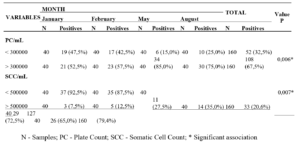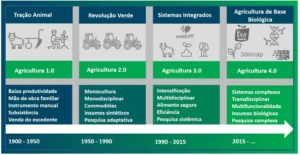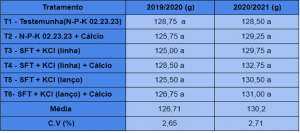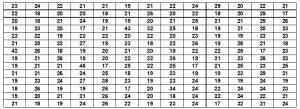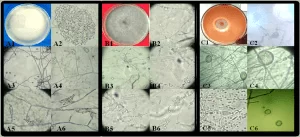ORIGINAL ARTICLE
SILVA, Jean Augusto Bueno da [1], MAI, Cátia Kelly Benedix [2], MELLER, Julio [3], CASALI, Renata Monteiro Collares [4]
SILVA, Jean Augusto Bueno da. Et al. Evaluation of post-harvest losses of potatoes and cabbage in a retail trade in Três de Maio, Rio Grande do Sul (RS). Revista Científica Multidisciplinar Núcleo do Conhecimento. Year. 07, Ed. 02, Vol. 03, p. 48-60. February 2022. ISSN: 2448-0959, Access link: https://www.nucleodoconhecimento.com.br/agronomy-en/post-harvest
ABSTRACT
Fruits and vegetables differ from other agricultural products due to their high perishability. One of the biggest problems in the production chain is the levels of post-harvest losses, along with inadequate management. In this context, the research problem is: what are the main causes of vegetable losses within a fruit and vegetable trade located in Três de Maio, Rio Grande do Sul? The main objective of this work is to evaluate and show an overview in a simple and direct way of the post-harvest scenario of fruits and vegetables sold to the fresh market, indicating the main causes for post-harvest losses and possible alternatives to minimize this situation. Therefore, a case study was carried out with a qualitative and quantitative approach. For data collection, it was necessary to interview the owner of the establishment, applying a questionnaire composed of 16 objective questions, covering aspects of production, flow, marketing and storage of vegetables. According to reports, the products are purchased weekly and, as a result of their sale, come from a nearby supply center. Upon receipt of the products, they are displayed on the display benches for consumers. According to the results obtained, the establishment has low rates of potato and cabbage losses, obtaining losses only when the products remain on the shelf for a long time or due to the occurrence of mechanical damage. Among the strategies to combat losses in the retail trade, it was found necessary to avoid conditions that are favorable to microbiological contamination of products as much as possible. Therefore, the importance of adopting preventive measures from the harvest of the products, cleaning, sanitization and transport to the final consumer, always valuing the best organoleptic quality.
Keywords: Post-harvest losses, Potato, Cabbage.
1. INTRODUCTION
To meet the growing world demand for food, it is necessary to increase its production, which can occur through the elevation and improvement of production areas and yield per crop area. However, it is essential that some measures are taken to reduce food losses from the farm to the consumer’s table, thus ensuring the food and nutritional security of these foods to those who will consume them. Thus, integration between all parties involved in the production chain is essential to have a more effective control of these losses, as each party involved directly affects, both negatively and positively, the next stage of this production link (FAO, 2011).
For Chitarra and Chitarra (2005), post-harvest losses can be defined as those that occur after harvest due to lack of marketing or consumption of the product at the indicated time. That is, damages occurred after harvesting, processing shed, transport, storage, processing and marketing of the salable product.
Vegetables differ from other agricultural products, mainly due to their high perishability. One of the biggest problems in the production chain is the post-harvest losses that, adding to factors such as mechanical injuries caused by inadequate packaging and incorrect handling that start on the rural property from the harvest of the product to the classification and selection of vegetables, contribute to the high losses in the marketing process.
In Brazil, according to Melo et al. (2013), fruit and vegetable losses represent a high cost to the retail sector, amounting to around 600 million reais per year, with 86% of these occurring during the exposure of the product for sale, another 9% in transport and 5% in storage. Data from the Associação Mineira dos Supermercados (AMIS)[5] also point to a loss of 750 million reais in food per year, considering supermarkets and grocery stores (EVANS, 2015).
Assessing post-harvest losses is of great importance for producers and traders, as it makes it possible to determine an ideal storage time that does not compromise the quality of the products and cause financial losses. Post-harvest shelf life is defined as the period of time within which a sample can maintain its quality attributes, such as flavor, aroma, texture, color, moisture, among others, before decomposition reaches a certain extent, resulting in the excessive maturity, dehydration and deterioration (HOLDSWORTH, 1988). In this way, intelligent analysis in the distribution of fruits and vegetables, when considering the shelf life of the products, can avoid unnecessary losses, also reducing economic losses (LANG et al., 2014).
In a study carried out by Guerra et al. (2017), in four different retail locations in the municipality of Santarém – Pará (PA), it was found that 45% of the potato tubers evaluated had some damage, whether mechanical, physiological and microbiological, which are characterized by dents, superficial cuts and damage/or deep, flayed, greenish, malformed, withered, sprouted, wet rot, and boring drills.
The same was verified by Eich; Braun and Tragnago (2020), in the municipality of Cruz Alta – RS, where potatoes had the highest volume of daily losses in local trade, in which of the 5,150 kg received, 498.02 kg were discarded. As for cabbage, the purchase volume was 1,901 kg and presented a daily discard of 459.25 kg. The damage of these two vegetables was related to handling and the way they are stored, in boxes or in sacks with a large volume.
Therefore, the guiding question is: what are the main causes of vegetable losses within a fruit and vegetable trade located in Três de Maio, Rio Grande do Sul? The main objective of the present study is to evaluate and show a simple and direct overview of the post-harvest scenario of fruits and vegetables sold to the fresh market, indicating the main causes for post-harvest losses and possible alternatives to minimize this situation.
2. THEORETICAL FOUNDATION
Losses that begin at harvest extend to consumer acquisition, including preparation before transport, production flow and marketing. Brazil is the third largest producer of fruit in the world, with 45 million tons, and one of the main producers of vegetables (18.7 million tons) (EMBRAPA, 2015; IBGE 2013). However, post-harvest losses are estimated to be between 40-50% (GUSTAVSSON et al., 2011). These already begin at harvest, with inadequate handling and, later, in the processing and classification, with a high incidence of impacts to the fruits (FISCHER et al., 2009).
Inadequate transport, without taking into account the physiological differences between the products and carried out under high temperature conditions, increases losses. When they reach the retail market, intensive handling and inappropriate placement on shelves favors even more losses. Costa et al. (2015) report that the reduction in post-harvest losses in food, in addition to contributing to the decrease in price, can also increase income and employment.
According to Jedermann et al. (2007), fruits and vegetables are a major challenge for retailers, as exposed to inappropriate conditions, such as exposure to low or high temperatures, and low or high relative humidities for a short period, they can suffer a significant drop in quality, enough to prevent its marketing. Despite the great diversity and availability of vegetables on the market, their high perishability makes marketing and handling difficult. Inadequate environmental conditions accelerate the loss of quality (CENCI, 2006).
Potato (Solanum tuberosum Doré) is the fourth most produced crop in the world, after wheat, corn and rice. This culture was one of the main sources of food for the Andean peoples who inhabited South America and, only after the 16th century, did it become part of the diet of the population living in Europe, Africa and North America (PEREIRA; DANIELS, 2003). Studies point out that Solanum tuberosum Doré is native to the mountains of Peru and Chile, where it was cultivated when the Spaniards arrived. There are botanical and cultural evidence at the site that indicate that “the potato was domesticated by the Collas, today Tiahuanaco, an Aymara culture that developed in western Bolivia, in the region between Lakes Titicaca and Poopó” (LUJÁN, 1996).
In Brazil, the potato crop was introduced by Portuguese settlers, where it was cultivated for family consumption, known as potato. Only with the beginning of the construction of railroads, it started to be called English potato, due to the technicians of the company responsible for the construction being English and demanding that the potato was present in their meals. Rio Grande do Sul, in 1940, was the largest producer in the country, where cultivation was concentrated mainly in the region of Pelotas, with supply to the rest of the country through the Port of Rio Grande (PEREIRA; DANIELS, 2003).
The potato crop has great economic and social importance in Brazil, especially in the South and Southeast regions. Its productive efficiency guarantees the use of areas destined for food production, an important feature in a world scenario with constant population growth and consequent food insecurity (SALES, 2011). It occupies the first place, both in planted area and in production volume and value. Brazilian potato production, in the last 10 years, has been stabilized at around 3.5 million t/year, obtained on average per 140 thousand cultivated hectares (AGRIANUAL, 2011).
The main causes of potato post-harvest losses are failures in the production phase, off-season harvesting, improper post-harvest processing (washing and drying), mechanical damage, inadequate packaging, handling and transport, prolonged exposure time in the retail market and unfavorable prices for the producer. There are several post-harvest potato handling systems in Brazil, which are adopted according to the growing region, processing equipment and destination market (HENS; BRUNE, 2004; LOPES, 2008).
Potato tubers can have different types of problems that affect their appearance. The most common defects in potato tubers caused by diseases and pests are as follows: wet rot, dry rot, rhizoctonia, burnt, vitrified, nematodes, pin borer, black heart, superficial damage, deep damage, dolling and greening.
The identification of post-harvest handling stages is important for the identification of critical points that cause the occurrence of losses, mainly mechanical injuries and diseases. For the consumer and the segments involved in potato marketing, one of the most important aspects is the appearance of the tubers, because it is associated with the product’s sales value.
According to Rinaldi (2011), in order to have a longer shelf life, it is important to know and use techniques that aim to reduce post-harvest losses, such as handling during harvest, transport and storage to the final consumer.
Cabbage (Brassica oleracea var. capitata), has been cultivated in Europe since 5,000 years BC, and is considered to belong to the wild cabbage family (B. oleracea var. silvestris). Worldwide, among the botanical varieties, it is the most economically important, being consumed by almost all peoples, whether: cooked, sautéed, in soups, raw salads, in preserves (German sauerkraut) and, the well-known, Arab cigar.
In Brazil, brassica is more consumed (SOARES et al., 2009). Cabbage is a very cultivated vegetable, mainly in the south and southeast of Brazil. Being from the cabbage family, both green and red cabbage outnumber broccoli, Brussels sprouts and cauliflower in consumption. Rich in fiber and low in calories, it is a good source of vitamin C and contains significant amounts of potassium, folate (folic acid) and beta-carotene.
The change in the eating habits of the Brazilian population in search of a better quality of life has encouraged the search for healthy foods, of excellent quality, guarantee of sanity, increasing the consumption of fresh vegetables and fruits (DURIGAN, 2004). The short shelf life of minimally processed products is due to tissue injuries, which induce physiological and biochemical responses that accelerate senescence, reducing quality and shelf life.
The main problems that affect the quality of cabbage (Brassica oleracea var. capitata), during storage, are related to the loss of color, drying, unpleasant smell and consequent short post-harvest shelf life (CARNELOSSI; SILVA, 2000). In order for minimally processed vegetables and fruits to remain with freshness, quality and health, processing is necessary that involves care from washing, cutting and packaging to sanitization (IFPA, 2009).
3. METHODOLOGY
The present work was carried out in a fruit and vegetable trade located in Três de Maio, Rio Grande do Sul, in order to present the post-harvest losses of potatoes and cabbage in the establishment used for the research, indicating the main causes for post-harvest losses and possible alternatives to minimize this situation. The study was carried out between August and September 2020.
In this study, qualitative and quantitative approaches were used, which, according to Lovato (2013), the conclusions are presented in a descriptive way and do not result from the collection of numerical data and statistical analysis, having a more abstract behavior, used to verify the physical aspect of the potatoes (Solanum tuberosum Doré), and cabbage (Brassica oleracea var. capitata). The quantitative approach was used to obtain data that contain numerical equivalence, being used to quantify the post-harvest losses of potatoes (Solanum tuberosum Doré) and cabbage (Brassica oleracea var. capitata) of the establishment. According to Lovato (2013), the researcher should focus on a particular program, event or activity. Therefore, the case study was used to identify the main causes for post-harvest losses and possible alternatives that can minimize this situation.
The data collection technique is based on intensive direct observation “a meeting between two people, so that one of them obtains information about a certain subject, through a conversation of a professional nature” (MARCONI; LAKATOS, 2017, p. 88). In this way, the interview was carried out weekly for four weeks with the person in charge of the retail store, to obtain data regarding the quality and physical aspect of the products under study. Descriptive statistics were used to analyze the data obtained.
The interview questionnaire consisted of 16 objective questions covering aspects related to the production, transport, commercialization and storage of these vegetables, with the objective of facilitating the understanding of those involved in the research, obtaining greater precision in the answers and a better exposure of results. With the information obtained, a previous diagnosis of the losses that occur in the post-harvest of potato (Solanum tuberosum Doré) and cabbage (Brassica oleracea var. capitata) was carried out.
The evaluations were carried out weekly, before the commercialization of the products to the final consumers, in which the owner made available the values that he acquires during each week, values that are discarded, values marketed, as it is part of the management of the merchant to control all commercialization of the products. In view of the amount sold and wasted, it was possible to determine, through bibliographic research, ways to better preserve potatoes and cabbage.
4. PRESENTATION, ANALYSIS AND DISCUSSION OF RESULTS
Through intensive direct observation, through a questionnaire and interview, we can obtain the following results regarding the vegetables under analysis at work:
Potato (Solanum tuberosum Doré) is purchased by the establishment for sale through Ceasa. Due to logistics and to have a longer shelf life, the product is generally received at a green ripening stage. The purchase of the product is carried out weekly. It comes boxed and, before being exposed for sale, it is processed. Afterwards, it goes through the free market type marketing process.
Due to the sales quantity, the establishment buys 100 kilograms of the product weekly and the purchase price varies from R$ 170.00 to R$ 180.00. The product is perishable and 6 kilograms of potatoes are discarded weekly. For sale, it is displayed on countertops and also stored on them. The merchandise remains at the point of sale for 4 days. The product that is not sold is donated. The causes of frequent losses happen when the product is mature. According to the owner of the establishment, to improve the quality of sales and reduce post-harvest losses there is not much to do, as the product spoils easily.
In a study carried out by Tofanelli et al. (2009) in Mineiros, Goiás (GO), it was found that the amount of potato tubers losses in relation to the weekly purchase volume was also low, as the volume purchased was 4,274 kg and the loss was 102.5 kg. The low volume of losses is related to the trader’s purchase volume and also the low diversification of vegetable crops. In addition, another factor that may have contributed to this reduced volume of losses in the two studies may be associated with storage conditions, such as the presence of a cold room and/or shelf that allow air circulation between the vegetables.
On the other hand, cabbage (Brassica oleracea var. capitata), which is also purchased from Ceasa, is generally received in the green maturation stage, due to logistics and to have a longer shelf life. The purchase of the product is carried out weekly. The cabbage comes boxed and, before submitting the product for commercialization, it is processed. Afterwards, the commercialization of the free fair type is carried out.
Due to the sales quantity, the establishment buys 50 units of the product weekly and the purchase price is R$ 4.00 per unit. It was found that the establishment cannot make the total sale of the product, because as it is perishable, it ends up being unfit for sale and, on average, 4 units are discarded weekly. The product is displayed for sale on countertops and is also stored on them. The merchandise remains at the point of sale for 4 days. As for leftovers, the product that is not sold is donated. The causes of frequent losses occur when the product becomes too old to be marketed. According to the owner’s opinion, the item sells well and holds up well.
According to Pereira et al. (2020), the percentage of cabbage losses in the retail trade of Chapadinha, Maranhão (MA), was 13.2%. This high percentage is associated with the storage location, as it does not have an adequate air conditioning system, causing the loss of water, leaving the product withered and with an undesirable appearance to the consumer. However, the result found in the present research portrays a percentage of weekly losses of 2% and the storage conditions have an adequate cooling system.
Thus, the place where the vegetables are stored and/or exposed for commercialization must be clean and with adequate ventilation and air conditioning conditions, in order to provide a longer shelf life, so that, in this way, it is possible to reduce losses in the place where they are being offered to customers.
5. CONCLUSION
The present study concludes that the establishment of fruits and vegetables presents low rates of losses. According to the owner, there are only losses in potatoes and cabbage when the products remain on the shelf for a long time and age or when they are already unloaded with some damage or injury, that is, mechanical damage caused by transport. In view of the small volume of fresh vegetables lost weekly, we can see that an establishment that correctly handles vegetables at the time of display, has all the necessary care to maintain their physical and apparent quality.
Fresh potatoes in natura and cabbage are foods much appreciated by Brazilian consumers. Due to this appreciation, it is important to maintain the quality of the product, which should be a constant concern of all those involved in the production system. Reducing consumption losses is very important to maintain the positive image that consumers have of the product.
Therefore, returning to the guiding question: what are the main causes of vegetable losses within a fruit and vegetable trade located in Três de Maio, Rio Grande do Sul? It was concluded that these losses come mainly from the transport of vegetables, since the merchant buys them at Ceasa, which is located in Porto Alegre, RS, about 480 km away from the target municipality of the study. And, this factor contributes to the occurrence of mechanical injuries in vegetables, reducing their shelf life, causing greater volumes of losses of these products.
The post-harvest loss control process begins even before vegetables and fruits reach the market. By preventing the products from being damaged during harvesting and transport, the producer guarantees, in addition to quality, a better price with consumers.
Among the strategies to combat the losses in the stands and shelves of the researched retail trade, it is necessary to avoid as much as possible conditions that are favorable to the microbiological contamination of the products. Therefore, the importance of adopting preventive measures, such as avoiding high temperatures, not exposing products to mechanical or physiological damage, avoiding their contact with contaminated water in the washing and sanitizing processes. And, finally, it is extremely important to keep the environments clean, free of garbage and fruit and vegetable waste, as decomposing organic matter can spread microorganisms through the premises and attract insects that transmit disease-causing organisms.
REFERENCES
AGRAFNP. Anuário da Agricultura Brasileira, 16. ed. São Paulo, 2011.
ASSOCIAÇÃO BRASILEIRA DE SUPERMERCADOS – ABRAS. Avaliação de perdas nos supermercados brasileiros. São Paulo: ABRAS, 2015.
CARNELOSSI, M. A. G; SILVA, E. O. Processamento mínimo de Couve e Repolho. In: Encontro nacional sobre processamento mínimo de frutas e hortaliças, Viçosa. Palestras, Universidade Federal de Viçosa. p. 125-131. 2000.
CENCI, S. A. Boas Práticas de Pós-colheita de Frutas e Hortaliças na Agricultura Familiar. In: NASCIMENTO NETO F. (Org.). Recomendações Básicas para a Aplicação das Boas Práticas Agropecuárias e de Fabricação na Agricultura Familiar. Brasília: Embrapa Informação Tecnológica, 1ª Ed. p. 67-80. 2006.
CHITARRA, M. I. F.; CHITARRA, A. B. Pós-colheita de frutos e hortaliças. Lavras, MG: Escola Superior de Agricultura de Lavras – FAEPE, 1990
COSTA, C.; ANTONUCCI, F.; PALLOTTINO, F.; AGUZZI, J.; SARRIÁ, D.; MENESATTI, P. A review on agri-food supply chain traceability by means of RFID technology. Food and Bioprocess Technology, v. 6, n. 2, p. 353-366, 2013.
DURIGAN, J. F. Panorama do processamento mínimo de frutas. In: ENCONTRO NACIONAL SOBRE PROCESSAMENTO MÍNIMO DE FRUTAS E HORTALIÇAS, 3., 2004. Viçosa: Universidade Federal de Viçosa, p. 9-12. 2004.
EICH, C.; BRAUN, G. C.; TRAGNAGO, J. L. Observação da perda de produtos hortifrutigranjeiros. Revista Interdisciplinar de Ensino, Pessoas e Extensão. v. 08. UNICRZ, 2020.
EMBRAPA. Secretária de Comunicação. Embrapa em números. Brasília, DF: Embrapa, 2015.138 p.
EVANS, L. Supermercados de Minas descartam 450 mil quilos de alimentos todos os meses. Belo Horizonte, 24 ago. 2015.
FAO. Global food losses and food waste. Disponível em PDF. International Congress Save Food. Rome. 2011.
FISCHER, I. H.; FERREIRA, M. D.; SPÓSITO, M. B.; AMORIM, L. Citrus postharvest diseases and injuries related to impact on packing lines. Scientia Agricola, v. 66, n. 2, p. 210-217. 2009.
GUERRA, Antonia Mirian Nogueira de Mora; COSTA, Ana Cecília Moura; FERREIRA, Júlia Batista Azevedo; TAVARES, Pala Raniele Freitas; VIEIRA, Thaís Silva; MEDEIROS, Aline Carla de. Avaliação das principais causas de perdas pós-colheita de hortaliças comercializadas em Santarém, Para. Revista Verde de Agroecologia e Desenvolvimento Sustentável. V. 12. N.1. pp. 34-40. 2017.
GUSTAVSSON, J.; CEDERBERG, C.; SONESSON, U.; OTTERDIJK, R.; MEYBECK. Global food losses and food waste: extent, causes and prevention. Rome: Food and Agriculture Organization of the United Nations, p. 1-38. 2011.
HENZ, G. P.; BRUNE, S. Redução de perdas pós-colheita em batata para consumo. Brasília, DF: Embrapa Hortaliças, 9 p. Embrapa Hortaliças. Circular Técnica, 34. 2009.
HOLDSWORTH, S. D. Conservación de frutas e hortalizas. Zaragoza – España. Editorial Acribia S. A. 186 p. 1988.
INSTITUTO BRASILEIRO DE GEOGRAFIA E ESTATÍSTICA – IBGE. Produção Agrícola 2012. Disponível em: https://www.ibge.gov.br/
JEDERMANN, R.; EMOND, J. P.; LANG, W. Shelf life prediction by intelligent RFID technicall limits of model accuracy. In: INTERNATIONAL CONFERENCE ON DYNAMICS IN LOGISTICS, 1., 2007, Bremen, Germany. Proceedings… Berlin: Springer.
JOYCES, T.; TAKEMATSU, A. P. Pragas que atacam repolho: alternativas para controle. 2010. Artigo em Hipertexto. Disponível em: <http://www.infobibos.com/Artigos/2010_1/repolho/index.htm>
LANG, W.; JANSSEN, S.; JEDERMANN, R. The intelligent container: a cognitive sensor net for fruit logistics. In: INTERNATIONAL CONFERENCE ON SENSOR NETWORKS (SENSORNETS 2014), 3. Lisbon, Portugal. Proceedings… Lisbon: Scitepress, p. 351-359. 2014.
LOPES, C. A. Boas práticas de campo produzem batatas sadias e incentiva a produção integrada. Batata Show, Itapetininga, Ano 8, n. 22, p. 71-73. 2008.
LOVATO, A. Metodologia da Pesquisa. Três de Maio: SETREM. 2013. ISBN 9788599020050.
LUJÁ, L. História de La Papa. Revista de La Papa, n.16, dez. [2009?]. Colômbia: FEDEPAPA. Disponível em: <http://wwwredepapa.org/lujan.pdf>.
MELO, E. L.; LOPES, J. S.; DEODORO, R. N.; MARUYAMA, U.; GUIMARÃES, A. A. O desafio do planejamento de demanda no setor hortifrutigranjeiro: um estudo de caso da Empresa Nova Casbri. In: SIMPÓSIO DE EXCELÊNCIA EM GESTÃO E TECNOLOGIA, 9., Rio de Janeiro. Anais… Alagoas: UFAL. 2012.
PEREIRA, A. dá S. A evolução da cultura da batata. In: CONGRESSO BRASILEIRO DE OLERICULTURA, 51., 2011, Viçosa. Horticultura Brasileira, Viçosa, v. 29, n.2
PEREIRA, R. Y. F.; FERREIRA, M. V. N.; CUNHA, W. P. da; RAMOS, D. de S.; SOUSA, F. B. F.; SOUSA, S. da S. N.; BARROSO, V. B.; OLIVEIRA, P. S. T. de. Perdas pós-colheita de hortifrúti e seus impactos financeiros no varejo do Município de Chapadinha, Maranhão. Society and Development. V. 9. N. 8. 2020.
RINALDI, M. M. Perdas pós-colheita devem ser consideradas. Planaltina, DF: Embrapa Cerrados. 2011.
SALES, L. L. S. R. Respostas fisiológicas e agronômicas da cultura da batata em função do espaçamento entre plantas e épocas de amontoa. Universidade Estadual do Centro-Oeste , Guarapuava. 68f. Dissertação (Mestrado em Agronomia), 2011.
SOARES, L. R.; PEREIRA, D. C.; MONTEIRO, V. H.; SOUZA, C. H. W.; KLEIN, M. R.; SILVA, M. J.; LORIN, H. F.; COSTA, L. A. DE M.; COSTA, M. S. S. DE M. Avaliação de substratos alternativos para produção de mudas de repolho. Revista Brasileira de Agroecologia, 4:1780-1783. 2009.
TOFANELLI, M. B. D.; FERNANDES, M. de S; CARRIJO, N. S.; MARTINS FILHO, Oscar B. Levantamento de perdas em hortaliças frescas na rede varejista de Mineiros. Horticultura Brasileira. v. 27. Pp. 116-120. 2009.
APPENDIX – FOOTNOTE
5. Minas Gerais Association of Supermarkets.
[1] Bachelor in Agronomy. ORCID: 0000-0002-6849-2174.
[2] Bachelor in Agronomy. ORCID: 0000-0001-9374-6984.
[3] Bachelor in Agronomy. ORCID: 0000-0003-0064-1978.
[4] Advisor.
Sent: November, 2021.
Approved: February, 2022.

